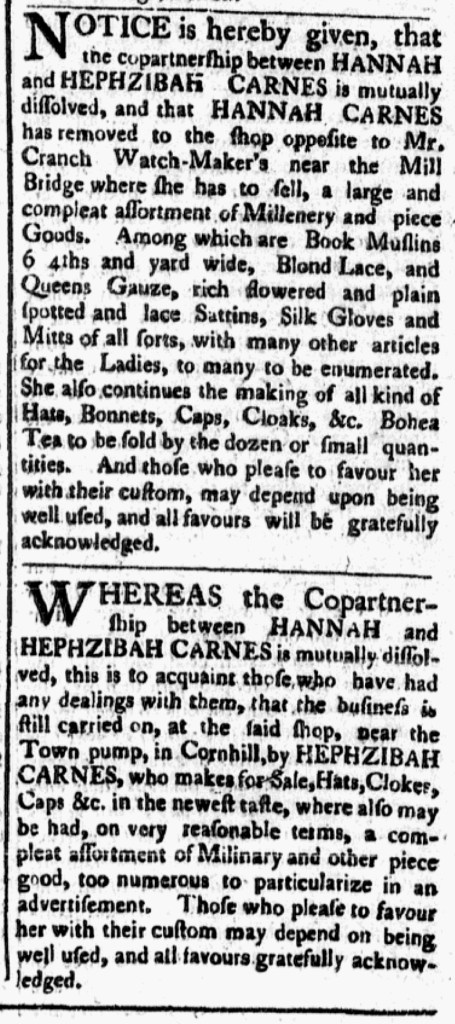What was advertised in a colonial American newspaper 250 years ago today?

“The copartnership between HANNAH and HEPHZIBAH CARNES is mutually dissolved.”
For a time in the early 1770s, Hannah Carnes and Hephzibah Carnes operated a millinery shop together. In December 1771, however, they “mutually dissolved” their partnership and set up their own businesses. The former partners became competitors, both placing advertisements in the Boston-Gazette and the Massachusetts Spy.
Both women were conscious of the costs of advertising. They placed their notices in only two of the five newspapers published in Boston at the time. In addition, each of them listed some of the items available among the “large and compleat assortment of Millinery and piece Goods” in their shops, but also stated that their wares were “too numerous to particularize in an advertisement.” Hannah went into greater detail in her advertisement, perhaps a necessity because Hephzibah remained in the shop “near the Town pump, in Cornhill,” and Hannah “removed to the shop opposite to Mr. Cranch Watch-Maker’s near the Mill Bridge.” With Hephzibah having the advantage of a location already familiar to former customers, Hannah may have found it necessary to elaborate on the goods and services she offered as a means of catching the attention of “the Ladies” that she hoped would seek out her new shop. Unlike Hephzibah, Hannah also mentioned that she sold “Bohea Tea” to entice prospective customers.
Their notices happened to appear one after the other on three occasions in the Massachusetts Spy, likely the result of happenstance rather than design on the part of the milliners. Hannah launched her advertising campaign first, placing a notice in the Boston-Gazette on December 23, 1771. It ran in that newspaper for five consecutive weeks. Hephzibah also placed advertisements in the Boston-Gazette, starting on December 30, but only for three weeks. On only one occasion, January 13, did their advertisements appear together. Once again, Hannah may have invested in more advertising in order to direct customers to her new location. Both women ran advertisements in the Massachusetts Spy on January 2, 9,16, and 30. In that newspaper, their notices appeared together in all but the January 16 edition. These variations suggest that compositors made decisions about the placement of the advertisements when they set the type for each issue. Hannah and Hephzibah may not have appreciated their advertisements appearing in such close proximity, but advertisers exercised little control over where their notices appeared in eighteenth-century newspapers.
